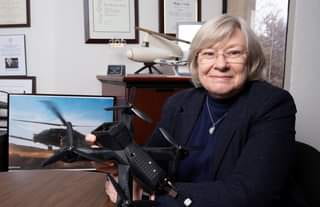New Tool to Help UAM Industry Design, Maintain Vertical Lift Vehicles Cost Effectively
By Anne Wainscott-Sargent
One day urban U.S. commuters will bypass choked roadways in favor of advanced vertical lift vehicles — a cross between a small propeller plane and a helicopter — to propel them to their daily destinations.
Achieving this reality first requires the industry to make the business case for using advanced materials for urban air mobility while also ensuring the aircraft operate with the highest safety standards.
A NASA-funded research effort led by Georgia Tech with four universities has made promising progress on that front with a first-of-its-kind analytics tool that will help the UAM industry make smarter materials choices when designing vehicles as well as enable operators operating air taxis to proactively monitor and maintain their fleets over the long run.

“We’re almost half way through our three-year project and about to release to NASA the first-generation tool to be able to look at the cost, the loading and the lifecycle issues associated with these vehicles,” says program PI Marilyn Smith, professor in Georgia Tech’s Daniel Guggenheim School of Aerospace Engineering and director of Georgia Tech’s Vertical Lift Research Center of Excellence, which conducts basic research on scientific barriers in technologies that support current and future vertical lift capabilities.
The challenge the team tackled was how to implement new structural materials, manufacturing techniques and maintenance/repair processes for these new vertical lift vehicles so they can be more affordable to build and maintain over their lifespan.
“We’re looking at how advanced structures work and understanding how they break, how they repair, and what’s the cost to repair them,” explains Smith.
She cites an example of two identical vehicles, one operating in San Francisco and one in Atlanta, explaining that each aircraft encounters very different wind and turbulence as it maneuvers around buildings and performs take offs and landings.
“The vehicle in San Francisco will experience more wind and turbulence than an eVTOL operating in Atlanta. That vehicle may need to do a maintenance after five hours of flight but the same vehicle flying in Atlanta may not need maintenance until 15 hours of flight. That’s important for cost savings,” she explains.
To provide this intelligence, the researchers have developed a PC-based operational analysis tool that Smith hopes will be offered free to the industry. During the build out of these vehicles, structural designers can use the tool to analyze which kind of materials are most robust. In addition, UAM operators can enter current flight data or historical data to estimate how much it will cost to operate the vehicle, factoring in routes and loads, as well as timing to replace components over the lifecycle of the vehicle.
Unlike military rotorcraft vehicles, which can be grounded for repair immediately, consumer air mobility fleets will need to operate continuously but also safely if they hope to be commercially viable. To meet those requirements, the tool can help monitor the vehicle for environmental sensor and component wear and tear, with the ability to know if an issue is serious enough to require immediate attention or more routine so it can be scheduled later for maintenance.
A key collaborator is Middle Georgia State University’s School of Aviation, which offers FAA-certified programs to train aviation structures mechanics. The Middle Georgia faculty guides the team on the cost, time and mechanic-level expertise required for certain repairs.
The University of South Carolina, teamed with Qarbon Aerospace and North Carolina A&T, is providing key insights into the efficacy of different and novel repair techniques, including life cycle fatigue, through hardware tests and digital twins. Qarbon is also evaluating the effect of manufacturing defects of components built with these advanced materials.
An industry review board reviewed the program last fall, providing input to the researchers. According to Smith, the biggest feedback they received was to focus more on raising the technology readiness level to get it closer to being commercially available.
“This is harder than it sounds because there aren’t vehicles that we can actually validate it against,” says Smith.
The team has tested the tool in the lab setting and will be engaging in some smaller scale flight testing. Smith says there is planning ongoing for limited full-scale testing and validation in 2024. She invites industry collaboration to help get the tool market-ready.
“If this is a tool that you’re interested in, and you’d like to find out more to get involved, to contact me. We’re always more than happy for industry people to join us and to give us feedback,” she says.
To learn more about this program and how to get involved, contact Georgia Tech at ms55@gatech.edu.
